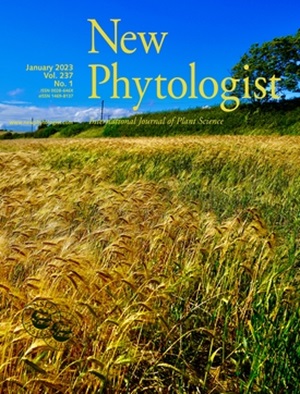The GW5-WRKY53-SGW5 module regulates grain size variation in rice
IF 8.1
1区 生物学
Q1 PLANT SCIENCES
引用次数: 0
Abstract
- Grain size is a crucial agronomic trait that affects stable yield, appearance, milling quality, and domestication in rice. However, the molecular and genetic relationships among QTL genes (QTGs) underlying natural variation for grain size remain elusive.
- Here, we identified a novel QTG SGW5 (suppressor of gw5) by map-based cloning using an F2 segregation population by fixing same genotype of the master QTG GW5. SGW5 positively regulates grain width by influencing cell division and cell size in spikelet hulls. Two nearly isogenic lines exhibited a significant differential expression of SGW5 and a 12.2% increase in grain yield. Introducing the higher expression allele into the genetic background containing the lower expression allele resulted in increased grain width, while its knockout resulted in shorter grain hulls and dwarf plants.
- Moreover, a cis-element variation in the SGW5 promoter influenced its differential binding affinity for the WRKY53 transcription factor, causing the differential SGW5 expression, which ultimately leads to grain size variation. GW5 physically and genetically interacts with WRKY53 to suppress the expression of SGW5.
- These findings elucidated a new pathway for grain size regulation by the GW5-WRKY53-SGW5 module and provided a novel case for generally uncovering QTG interactions underlying the genetic diversity of an important trait in crops.
GW5-WRKY53-SGW5模块调控水稻的粒度变化。
谷粒大小是影响水稻稳产、外观、碾磨质量和驯化的重要农艺性状。然而,谷粒大小自然变异所隐含的 QTL 基因(QTGs)之间的分子和遗传关系仍然难以捉摸。在此,我们通过固定主 QTG GW5 的相同基因型,利用 F2 分离群体进行基于图谱的克隆,发现了一个新的 QTG SGW5(gw5 的抑制因子)。SGW5 通过影响小穗谷壳中的细胞分裂和细胞大小来积极调节谷粒的宽度。两个近似同源的品系表现出 SGW5 的显著差异表达,谷粒产量增加了 12.2%。在含有低表达等位基因的遗传背景中引入高表达等位基因会导致谷粒宽度增加,而敲除高表达等位基因则会导致谷粒外壳变短和植株矮小。此外,SGW5 启动子中的顺式元件变异影响了其与 WRKY53 转录因子的不同结合亲和力,从而导致 SGW5 的不同表达,最终导致谷粒大小的差异。GW5与WRKY53在物理和基因上相互作用,抑制了SGW5的表达。这些发现阐明了GW5-WRKY53-SGW5模块调控谷粒大小的新途径,为普遍揭示农作物重要性状遗传多样性背后的QTG相互作用提供了新的案例。
本文章由计算机程序翻译,如有差异,请以英文原文为准。
求助全文
约1分钟内获得全文
求助全文
来源期刊

New Phytologist
生物-植物科学
自引率
5.30%
发文量
728
期刊介绍:
New Phytologist is an international electronic journal published 24 times a year. It is owned by the New Phytologist Foundation, a non-profit-making charitable organization dedicated to promoting plant science. The journal publishes excellent, novel, rigorous, and timely research and scholarship in plant science and its applications. The articles cover topics in five sections: Physiology & Development, Environment, Interaction, Evolution, and Transformative Plant Biotechnology. These sections encompass intracellular processes, global environmental change, and encourage cross-disciplinary approaches. The journal recognizes the use of techniques from molecular and cell biology, functional genomics, modeling, and system-based approaches in plant science. Abstracting and Indexing Information for New Phytologist includes Academic Search, AgBiotech News & Information, Agroforestry Abstracts, Biochemistry & Biophysics Citation Index, Botanical Pesticides, CAB Abstracts®, Environment Index, Global Health, and Plant Breeding Abstracts, and others.
 求助内容:
求助内容: 应助结果提醒方式:
应助结果提醒方式:


